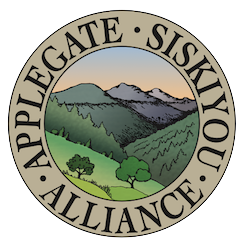
The Late Mungers Vegetation Management Project includes two large, industrial timber sales on the ridge system dividing the Applegate from the Illinois Valley. This ridge system is important for habitat connectivity and includes a large block Late Successional Reserve (LSR) forest set aside to protect habitat for the northern spotted owl.

Located in the mountains above Williams, Oregon, we have reported extensively on the Penn Butte Timber Sale, which proposes logging units on Mungers Creek, China Basin Creek, and Powell Creek above the pastoral Williams Valley and the small hamlet of Williams, Oregon.
However, another timber sale is also being proposed in the mountains between Murphy in the Applegate Valley, and Selma in the Illinois Valley. Known as the Late Mungers Timber Sale, the BLM has proposed logging a series of timber sale units totaling approximately 500 acres of LSR forest.
Recently, we visited the Late Mungers Timber Sale which targets mature, late successional and old-growth forest with heavy industrial logging. Although the treatments proposed throughout the timber sale will be damaging, this post will identify the worst units we have surveyed in the Late Mungers Timber Sale.
Unit 5-1
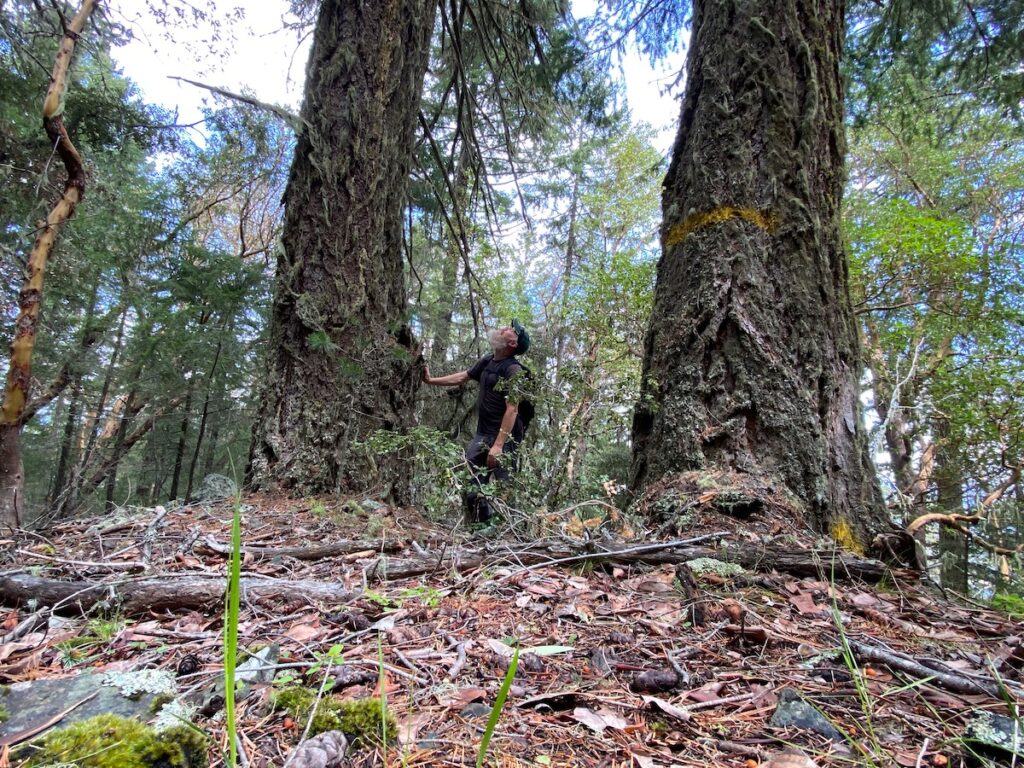
Unit 5-1 is located at the headwaters of both Black Canyon Creek and Grays Creek. These obscure tributaries flow north into the Applegate River from the forested ridgeline below Pennington Butte, downstream of Provolt, Oregon.
Small portions of the unit extend below road 38-5-6.1 in the Black Canyon Creek watershed, while other, more intact portions are located above the road and extend to a forested ridgeline, then into the headwaters of Grays Creek. These more intact portions of the unit include mature and late successional forest, along with a significant block of old-growth, surrounded on two sides by young, dense stands regenerating from previous clearcut logging operations. This corridor of old forest provides connectivity in an area otherwise devoid of mature and late successional habitat. Unfortunately, this corridor of habitat is also proposed for logging in the Late Mungers Timber Sale.

Much of this beautiful stand is relatively open spaced, with groupings of mature and old-growth trees growing in a diverse clump formation. The stand contains important closed forest habitat, dominated by large, old trees between 20″ and over 50″ diameter, including Douglas fir, ponderosa pine, and sugar pine. Between the large conifer groupings a well developed mosaic of live oak and madrone woodland has colonized the canopy gaps and matured into a diverse and productive mixture of habitat types.
At the headwaters of Grays Creek, the unit contains mature, mid and late successional forest habitats, including closed stands of pine and fir targeted for aggressive group selection logging and heavy commercial thinning operations.
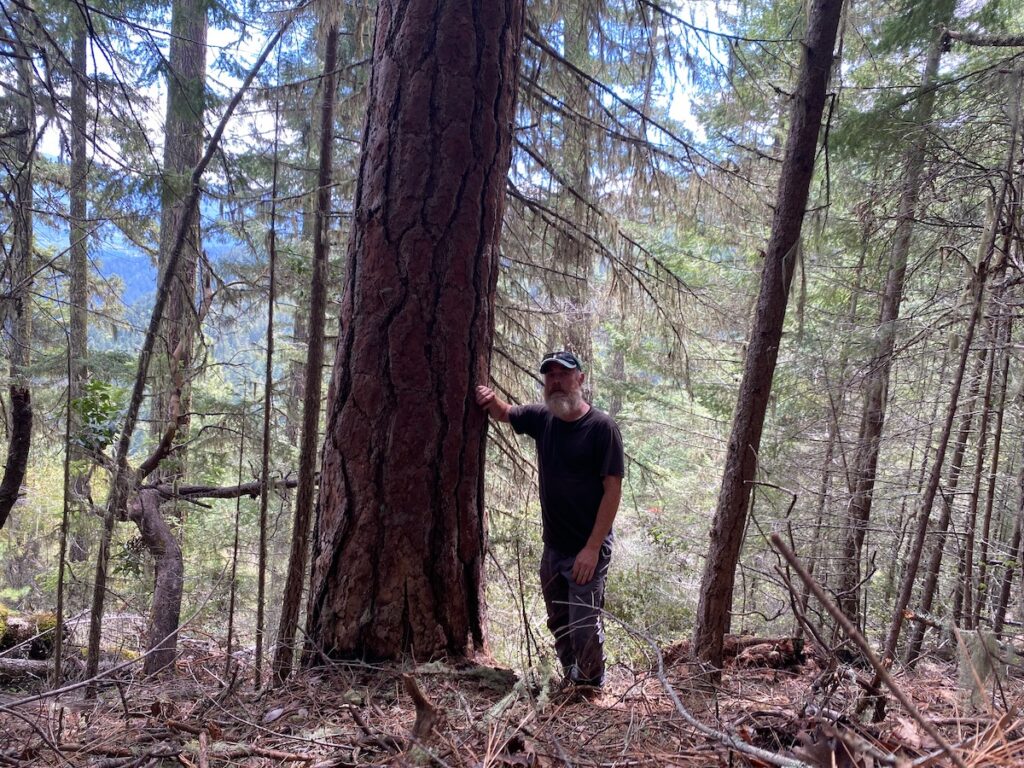
The proposed tree removal mark throughout this unit is extremely heavy handed and will damage LSR forests, late successional habitat values, habitat connectivity, and habitat complexity. In many locations, trees between 30″ and 45″ diameter have been identified for removal, and in other locations, entire old forest groupings dominated by large, carbon and habitat rich trees are proposed by the BLM for removal. This includes a number of large, old Douglas fir trees up to 45″ diameter and open-grown ponderosa pine trees up to 30″ diameter. (Note: The Late Mungers Timber Sale is “leave” or “retention tree” marked, meaning only trees marked with red or yellow paint would be retained in timber sale units. Trees that will be logged are not marked with spray paint.)
Many of the trees targeted for removal exceed the 36″ diameter and 156-year-old tree removal limits identified in the BLM’s 2016 Resource Management Plan (RMP). The removal of these trees is a violation of existing management plans, is inconsistent with LSR management and will impair northern spotted owl habitat values for decades to come.
Unit 5-1 contains important old forest habitat that should be retained as high quality northern spotted owl habitat, for its carbon storage, and for its naturally high levels of fire resistance.
Unit 7-1
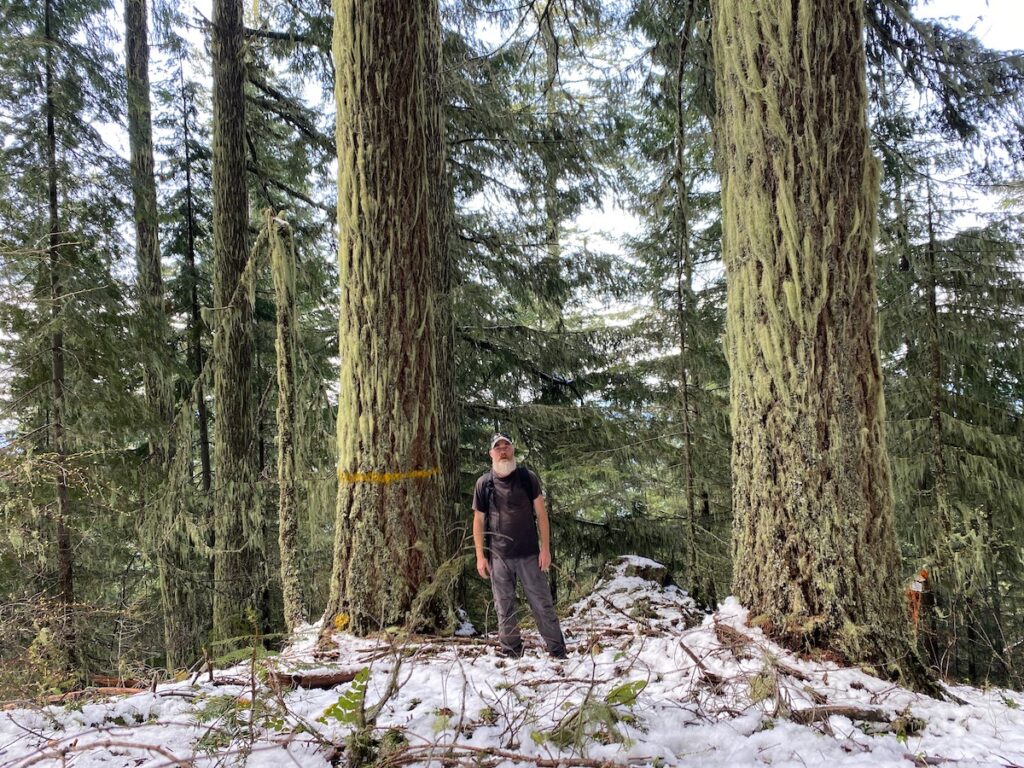
On the northern slope of the ridgeline dividing Powell Creek from Murphy Creek, unit 7-1 is located at a higher elevation than most of the Late Mungers Timber Sale, and extends into a more productive montane forest of Douglas fir and scattered white fir at the headwaters of Murphy Creek. The stand contains mature to late successional forest components, large old trees, a closed canopy, and patches of structural complexity.
Unit 7-1 surrounds a large block of nesting habitat for the northern spotted owl, and although not identified as such by the BLM, it appears to support nesting habitat as well. Given the relatively productive forest conditions, this stand will continue developing habitat complexity, accumulating and recruiting large snags, downed wood and living trees through forest succession and time. The logging proposed in the Late Mungers Timber Sale will only disrupt this process, degrade habitat conditions, and remove important habitat elements.
This stand is also relatively fire resistant with a high canopy, a dominance by large trees, and relatively cool, moist habitat conditions. The canopy shading provided by large old trees also serves to suppress understory growth, and in so doing, naturally reduces fire risks.
The dramatic canopy cover reduction, the removal of large, fire resistant trees, and the alteration of microclimate conditions proposed in the Late Mungers Timber Sale will trigger both stand drying and the development of dense, woody understory fuels as young, highly flammable trees and shrubs regenerate and fill in the canopy gaps created by group selection logging and heavy commercial thinning operations.

Additionally, roughly one mile of new road is proposed for construction on the beautiful ridgeline above and across the steep mountain slopes of unit 7-1. This new road will impact intact habitats, increase noxious weed spread, create excessive erosion, and encourage illegal OHV use, while facilitating commercial logging that will degrade forest habitats, increase fire risks and contribute to the climate crisis.
Unit 22-1

Unit 22-1 is located at the headwaters of Murphy Creek in an area heavily logged decades ago. Much of unit 22-1 is a plantation forest recovering from previous logging treatments, yet the narrow eastern portion of the unit contains a beautiful mature and mid-successional mixed conifer forest with snags, downed wood, some large dominant trees, and generally complex forest habitats that have never been logged. The soils are extremely rocky with some impressive rock outcrops and very little understory growth. Understory fuel development is currently moderated by overstory canopy growth, keeping fire risks to a minimum. The lower portion of the stand also contains a beautiful mountain spring at the head of Murphy Creek.
We found a few 30” diameter trees and a large 38″ diameter tree identified for logging in this unit, and if implemented, enough canopy would be removed through logging to both trigger an understory shrub response and significantly degrade habitat conditions for the northern spotted owl.
Unit 15-1
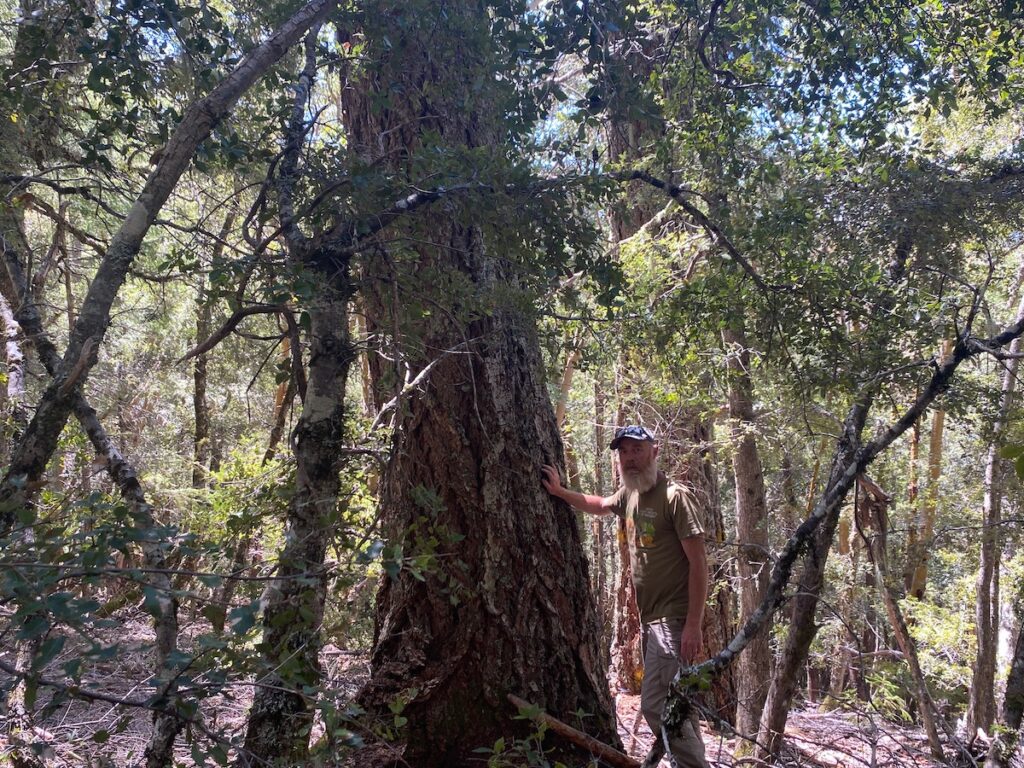
Unit 15-1 straddles the ridgeline between Deer Creek and Murphy Creek, and contains some large, old trees over 50” diameter. The south-facing slopes in the Deer Creek watershed contain mixed conifer and hardwood groves with intact stands of live oak and madrone woodland. Patchy, low density groves of large, fire-resistant conifer species growing as islands among the canopy of hardwood trees that have colonized this harsh, ridgetop since the last mixed severity fire.
The forest and woodland in unit 15-1 do not need fuel reduction or forest health treatments and are maturing nicely without intervention. Despite minimal overstory conifer growth, trees up to 36” are identified for removal in the stand, removing some of the most fire resilient, mature trees to pierce through the canopy of hardwood forest.
This unit also extends onto the north-facing slope which contains a significant hardwood component and younger stands of Douglas fir.
Conclusion:
The logging proposed in the Late Mungers Timber Sale would dramatically reduce canopy cover, remove large, fire resistant trees, alter microclimate conditions, degrade habitat complexity, damage northern spotted owl habitat, reduce old forest, snag and downed wood recruitment, release abundant stored carbon and increase fire risks.

Recent research by scientists at Oregon State University has demonstrated that the logging and wood products industry are the biggest producers of greenhouse gas emissions in the state of Oregon (Law. 2018). The type of old forest logging proposed in the Late Mungers Project is particularly troubling because it proposes to transform our beautiful old forests from important carbon sinks into dangerous carbon sources. The Medford District BLM is steadily converting carbon rich old forests across southwestern Oregon into carbon bombs that will only further compound current climate impacts.
The agency is also steadily converting fire resistant old forest, with currently cool, moist habitat conditions, into hot, dry, windswept habitats dominated by young, highly flammable regeneration. The removal of large, old trees and excessive levels of canopy cover (to as low as 30%) would increase fire risks on BLM lands and threaten nearby communities. The large, dominant trees proposed for logging in the Late Mungers Timber Sale and the excessive canopy reduction identified on the ground will dramatically increase fire risks on both the stand and landscape scale.
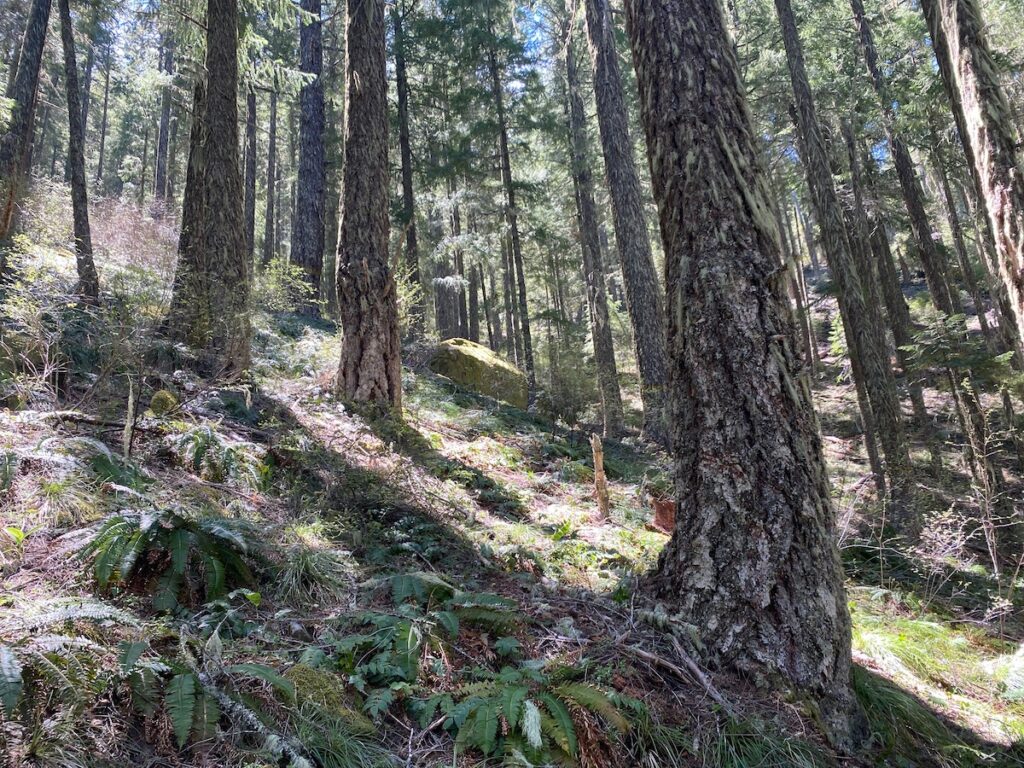
The Late Mungers Timber Sale and the old forest logging it proposes is a violation of President Biden’s Executive Order on forests and an unacceptable impact to the mature and old-growth forests that stabilize our climate, maintain fire resilience, and safeguard our clean water. We ask the Medford District BLM to comply with President Biden’s Executive Order on old forest and climate, to become part of the solution, and to cancel the Late Mungers Project!
Take Action!
Please comment on this project by 5pm June 28,2022. For more information and talking points that can be used to inform your official comments, please review this previous blog post: https://applegatesiskiyoualliance.org/blm-proposes-late-mungers-and-penn-butte-timber-sales-in-the-applegate-valley-comment-now/
Comments can be made at the following BLM website: https://eplanning.blm.gov/eplanning-ui/project/2018484/570
